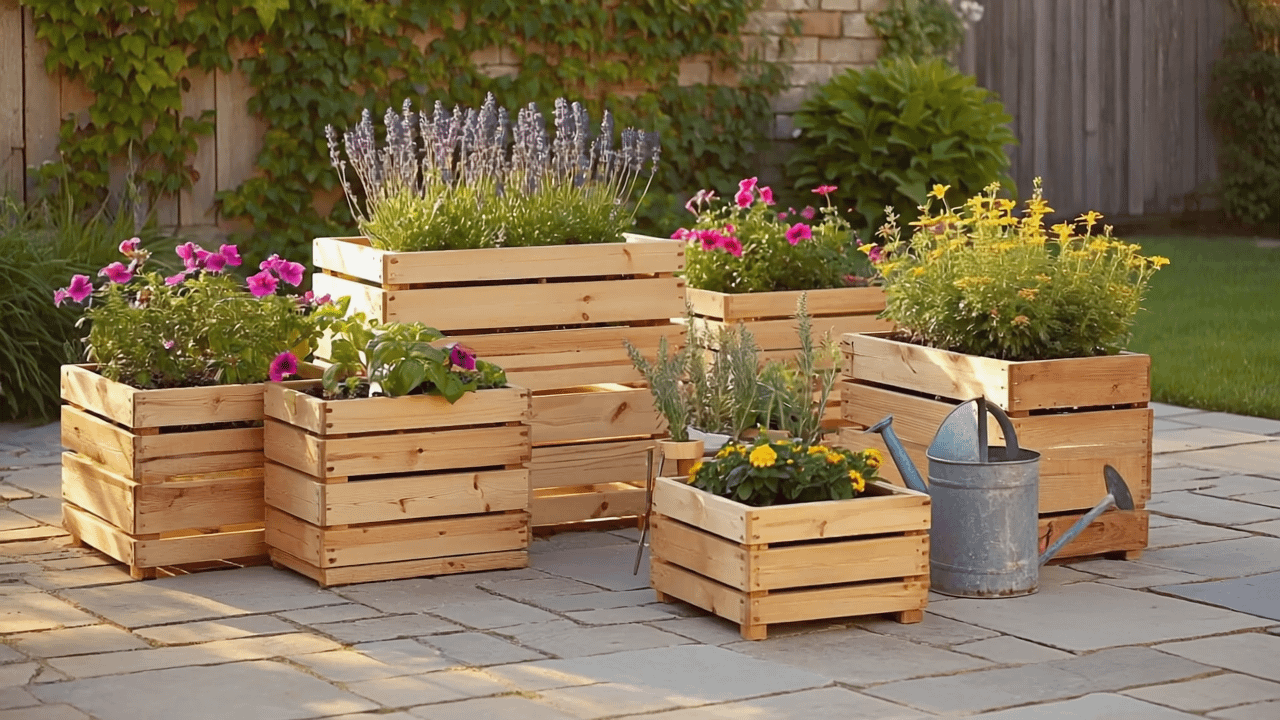DIY Wooden Planter Box: Easy Step-by-Step Guide for Beginners

I’ll never forget the first planter I built.
I used cheap pine from the hardware store. Cut it square. Glued it up. Filled it with soil and my wife’s favorite basil.
Two months later?
It was gray.
Warping.
The bottom had rotted through, and soil was leaking onto the deck.
My wife didn’t say a word.
But her sad basil said everything.
That’s when I learned: a planter isn’t just a box. It’s a home for living things — and it needs to last.
After 10 years of building outdoor planters — in humid Florida, dry Arizona, and rainy Oregon — I’ve cracked the code.
And today, I’m giving you the exact method to build a DIY wooden planter box that’s:
- Beginner-friendly (simple cuts, no fancy tools)
- Weather-resistant (won’t rot after one season)
- Custom-sized (fits your space, your plants, your style)
- Built to last (your herbs will outlive the planter… if you do it right)
Let’s grow something beautiful — together.
Why Most DIY Wooden Planter Boxes Fail (Before Summer’s Over)
Most beginners make one of three mistakes:
- They use indoor wood → Pine looks cheap and rots fast outdoors.
- They skip drainage → Trapped water = rot city.
- They let it sit on wet ground → Bottom boards soak up moisture like a sponge.
But the real secret?
Start with the right wood, design for drainage, and lift it off the ground.
Get this right — and your planter will still be thriving when your neighbor’s plastic one is cracked and faded.
The 5 Best Woods for Your DIY Wooden Planter Box
Not all wood is created equal outdoors. Here’s what actually works:
🌲 Western Red Cedar (Top Pick)
- Naturally rot-resistant
- Lightweight and easy to cut
- Ages to a soft silver (or stays rich with finish)
- Perfect for beginners
🌲 Cypress
- Handles humidity like a champ
- Great for rainy or coastal climates
- Slightly more affordable than cedar
🌲 Redwood
- Gorgeous color and natural durability
- Harder to find (and pricier)
- Worth it for showpiece planters
🌲 Pressure-Treated Pine (Budget Option)
- Chemically treated to resist rot
- Not as pretty, but it works
- Only use ACQ-treated (safer, modern formula)
❌ Avoid: Untreated pine, poplar, birch — they’ll rot in months.
📌 Want more outdoor wood tips? See our full guide to the 5 Best Wood Types for Outdoor Furniture .
What You’ll Need (Mostly Tools You Already Own)
🛠️ Tools:
- Tape measure & pencil
- Saw (circular, miter, or handsaw)
- Drill + bits
- Clamps
- Sandpaper (80 → 220 grit)
- Safety glasses (always)
🪵 Materials:
- Wood: ¾” cedar or cypress (for sides and bottom)
- Screws: Exterior-grade (stainless or coated)
- Wood glue: Titebond III (water-resistant)
- Drainage: Landscape fabric + gravel (optional)
- Finish: Outdoor wood sealer or natural oil
Step 1: Plan Your Planter Box
Before you cut:
- Decide size: Depth (6–12”), width, length
- Account for wood thickness: A 12” box needs 10.5” bottom if using ¾” wood
- Sketch it out: Simple rectangle = easiest for beginners
Pro Tip: Start small. A 12” x 6” x 6” herb box is perfect for your first build.
Step 2: Cut and Assemble (The Fun Part!)
Cut these pieces (for a 12” long, 6” wide, 6” tall planter):
- Sides: 2x @ 12” long
- Ends: 2x @ 6” long
- Bottom: 1x @ 10.5” x 4.5”
Assembly:
- Glue and clamp the sides to the ends.
- Pre-drill holes to prevent splitting.
- Screw together with exterior screws.
- Attach the bottom inside the box (don’t nail through the bottom — it’ll leak).
- Check for square — use a speed square or measure diagonals.
🧑🔧 Daniel’s Story: I once skipped the glue and just screwed it together. After a heavy rain, the joints loosened. Soil everywhere. Now, I always use glue + screws — it’s a team effort.
Step 3: Drainage Is Non-Negotiable
This is where 90% of planters fail.
Do this:
- Drill 3–5 holes (½” diameter) in the bottom.
- Line the inside with landscape fabric (keeps soil in, lets water out).
- Add 1” of gravel at the bottom (optional but helpful).
Never skip this. Your plants — and your wood — will thank you.
Step 4: Finish and Elevate
- Sand smooth: 120 → 180 → 220 grit
- Apply finish: Even on the inside — moisture doesn’t care what you see.
- Add feet: Glue small wood blocks or plastic risers to the bottom.
→ This keeps the planter off wet surfaces — doubles its lifespan.
📌 For more outdoor project ideas, check out our Weekend Outdoor Furniture Projects .
Pro Tips That Make You Look Like a Pro
- Pre-finish all parts before assembly (hard to reach inside later)
- Use stainless hardware — regular screws rust and stain your wood
- Round the top edges with sandpaper or a router — feels nicer, looks cleaner
- Build it in the shade — direct sun dries glue too fast
Before You Cut Your First Board — Tune Your Saw
Here’s the truth no one tells you:
Your DIY wooden planter box is only as good as your cuts.
A misaligned table saw = crooked joints = gaps where water collects = rot.
I used to blame the wood. The weather. The glue.
Then I realized: my saw was off by 1/32”. That’s all it took to ruin the fit.
That’s why I created the FREE “Dead-Square Every Time” Table Saw Tune-Up Checklist.
It’s a 15-minute guide to calibrating your saw for perfect 90° cuts — no dial indicator needed.
It’s the first step to builds that last — not just survive the season.
You’ve Got This
Building a DIY wooden planter box isn’t about fancy tools or years of experience.
It’s about choosing wisely, building well, and caring for your craft.
Do it right — and you’ll have a planter that thrives for years, growing herbs, flowers, or veggies in a home you built with your own hands.
Go grow something beautiful.
— Daniel
HMZ Woodz
